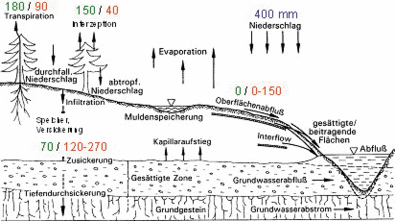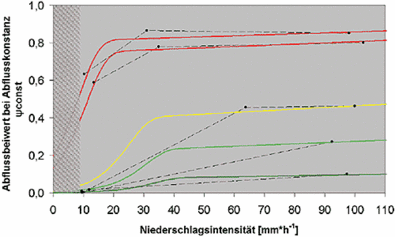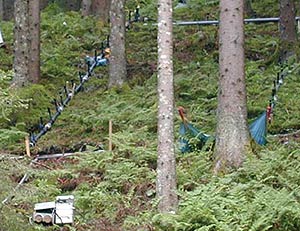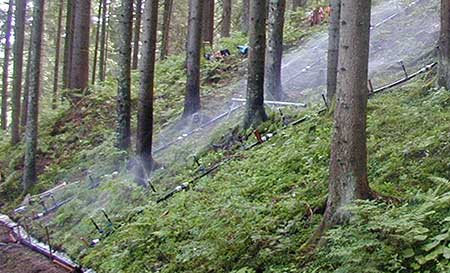
What are the hydrological effects of forest vegetation on surface runoff in alpine catchments?
Hydrological Effects of Mountain Forests
The increase in frequency of extreme events such as floods, mudflows and landslides has led to many questions concerning the efficiency of technical control measures, methods of biological engineering and surface management of concerned areas. In former times, ecosystem integrity has been considered as an “insurance” against natural hazards. In the past years the protective role of forest vegetation against natural hazards has been increasingly questioned.
The authors draw a positive picture of the way forests protect against natural hazards. This depiction is based on numerous hydrological studies and analyses of disasters in many torrent catchments of the Eastern Alps.
High protection function of forests or no difference between forest vegetation and grassland?
A series of studies published in recent years critically questions the hydrological function of forest vegetation, especially during persistent precipitation events. HEGG et al. (2004) summarise as follows: “Under similar precipitation conditions, depending on the soil, forests may have a protection function or not”. BURCH et al. (1996) did not find a statistically significant correlation between degree of forestation and flood runoff peaks. COSANDEY et al. (2005) evaluated several forest hydrological studies in Southern France. The results of this evaluation differed considerably from one site to another, indicating the degree of complexity of the rainfall/runoff relationship.
Impact of forest vegetation on water balance
According to tree species and crown density alpine forests can retain 4 to 6 mm of water in the canopy during one single precipitation event (AULITZKY and THURNER, 1982); BREITSAMER 1996; MARKART 2000; WEISKOPF, 2002).
Low canopy cover, less interception
With decreasing canopy density the interception performance decreases as well, both during single events and at the annual average. For example, harvesting of 55 % of woody mass in a spruce-fir-beech stand of the Tegernsee Mountains in Bavaria reduced the interception rate from 25 % of the annual precipitation to clearly below 20 % (BREITSAMETER 1996).
Interception capacity depends also on the temporal and quantitative distribution of precipitation. During frequent events with high precipitation intensity retention of the canopy is much lower than during low intensity precipitation with repetitive interruptions and phases of desiccation. Due to interception by forest stands in the Eastern Alps one fifth of the annual precipitation will never reach the ground.
Active Evaporation of a spruce stand: 500 to 600 mm of water annually.
The evaporation capacity of vegetation cover depends to a high extent on the precipitation distribution also. Figure 1 shows the total evaporation capacity of a series of catchments covered by spruce, according to the study by MENDEL (2000), arranged by categories of annual precipitation sums.
At an annual precipitation of 750 mm, almost 90 % are evaporated, around 40 % are given back to the atmosphere when precipitation is about 1200 mm. When annual precipitation exceeds 2000 mm evaporation decreases to a value of about 20 %. In absolute figures, this means that a typical spruce stand gives back between 500 and 650 mm of water to the atmosphere by active evaporation.
Calculations of the water turnover of a densely stocked 25 years old cembran pine stand (Pinus cembra) in Haggen in the Sellraintal of Tyrol by MARKART (2000) showed transpiration values between 26 and 55 % for 400 mm precipitation during the summer months from July to September. Under favourable precipitation patterns almost no deep percolation took place on the afforested plots. Water supply in the soil decreased much quicker in cembran pine plantations than in a neighbouring area covered with grass and herb vegetation. Water uptake from the roots by tree vegetation and evaporation into the atmosphere by needles or leafs (active evaporation/transpiration) was clearly higher – double to four times as high – in comparison to an alpine sward (Fig. 2).
Soils under forest or alpine dwarf shrubs show higher retention capacity
Under comparable precipitation patterns soils under forest or alpine dwarf shrubs show a much higher retention capacity than soils under short growth vegetation such as alpine sward. This is due to their high interception and transpiration performance.
According to BREITSAMETER (1996) thinning of spruce-fir-beech-stands in the Flysch zone and in the Limestone Alps of the Tegernsee Mountains led to a decrease of less interception and evaporation on the one hand and an increase of soil moisture contents on the other hand. The older and the more densely stocked the trees, the higher is the water tension in the densely rooted zone. Also HAGER (1988) observed a typical saturation pattern depending on the thinning intensity of his spruce-trial plots at the Jauerling in Lower Austria. The looser the structure of a forest stand the slower and less deep will be dehydration of the soil.
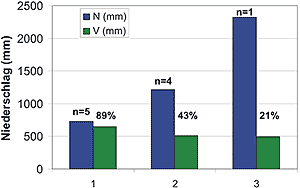
Figure 1: Annual-total-evaporation of forested catchments in Germany – Data for spruce; Analysis of tabular quotations in MENDEL (2000); N = annual precipitation, V = evaporation, n = number of catchment basins in each category; Category 1: 703 mm N 803 mm, Category 2: 1.066 mm N 1.299 mm, Category 3: N = 2.320 mm
Influence of forest vegetation on runoff formation during torrential rain
According to COSANDEY et al. (2005) the discussion about the hydrological effects of forests (based on examples from Southern France) should focus on the issue of soil without ground cover versus vegetation covered soil. To his mind, comparing the effect of forest vegetation with other vegetation forms is of minor importance.
The current scientific knowledge about the Eastern Alps does not reflect this opinion. A series of field investigations demonstrate that, due to the high share of dead organic substances, the non-woody species such as Nardus stricta or individual forms of Festuca sp. - widely occurring in the Alpine space - drastically reduce the infiltration capacity of mineral soil (thatched roof-effect) hence causing high levels of surface runoff (MARKART et al. 1996, 2000), and without even considering anthropogenic interventions such as grading or grazing on alpine pastures.
Forest vegetation and dense dwarf-shrub cover reduce surface runoff
The positive hydrological effects of forest vegetation or dense dwarf-shrubs in torrential rain does not primarily result from the interception performance at the moment of the precipitation event but from the breaking of the kinetic energy combined with regulated runoff via soil vegetation and humus layer, mitigating the kinetic impact of the rain drops by dosed discharge into the mineral soil and the geological subsoil.
Decayed tree roots may act as hollows for years and decades (AIGNER 1991) favouring quick water discharge. This leads to an increase in water discharge which may be substantial but, according to WOHLRAB et al. (1996), is at least twenty times slower than surface runoff.
Since the end of the 19th century a number of studies tried to make a quantitative assessment of different runoff and infiltration properties of forest and non-forest sites (open field). Already the studies by ENGLER (1919) show impressively that “during thunderstorms the runoff factor is less significant for forests than for the open field”.
After initial losses due to interception in the canopy and in the leaf mould (between 5 and 10 mm at a maximum), according to SCHWARZ (1986) 10 to 30 mm of precipitation would be needed to reach partial saturation of the upper coarse textured soil layer (A-horizon) and to trigger near surface interflow (EINSELE et al. 1986).
Studies by BREITSAMETER (1996) in the Flysch zone and in the Limestone Alps of the Tegernsee Mountains reveal that a densely structured mountain forest forms an integral protection against surface erosion in the mountainous regions. Measurable erosion from forested areas develops primarily in gullies and ditches as well as in the adjacent steep riparian zone. Even in the case of strong thinning up to half of the forest cover BREITSAMETER could not observe any surface runoff or soil erosion; an effect due to a favourable soil structure (high pore volume, coarse textured material, high aggregate stability) and intensive root penetration.
In case of surface runoff formation often only the runoff coefficient, that is the relationship between surface runoff and precipitation amount, is considered. But especially the temporal delay of runoff formation plays a major role in flood formation.
At the Department of Natural Hazards and Alpine Timberline (DNA) at the BFW, based on the results of more than 230 simulations of torrential rain (sprinkling experiments with a spray irrigation installation applied to a plot size of 50 to 100 m²), concentration time for various vegetation types with varying runoff disposition has been calculated (Table 1). The concentration time is the time period between the start of the precipitation event and the moment, when a balance between input and output is reached, i.e. maximum runoff is achieved (SIFALDA 1966).
| Table 1: Decrease of initial abstraction with increasing runoff disposition | ||
| Initial abstraction (in min) | Runoff coefficient class (AKI) | Surface runoff in % of precipitation |
| infinite | 0 | 0 |
| 28 | 1 | 1 - 10 |
| 20 | 2 | 11 - 30 |
| 15 | 3 | 31 - 50 |
| 11 | 4 | 51 - 75 |
| 7 | 5 | 75 - 99 |
| 5 | 6 | 100 |
The results show that forest vegetation and alpine dwarf-shrubs fall under the categories showing low runoff disposition (BUNZA et al. 1996; LÖHMANNSRÖBEN et al. 2000; MARKART et al. 2004). Generally, roughness of both vegetation forms is high. Runoff is slowed down because of the large surface and the multi-layered vegetation structure (tree layer, herbaceous-/dwarf shrub layer, moss layer, humus layer, mineral soil). Therefore, peak runoff is considerably delayed in forested catchments being significantly lower (COSANDEY 2005).
Forest vegetation – runoff behaviour in dependence of antecedent soil moisture content
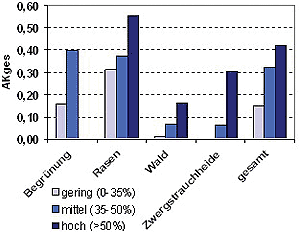
Figure 3: Influence of antecedent moisture content on surface runoff according to vegetation unit (n = 78 trials, < 35 % of total pore volume (PV) = low, 35-50 % of PV = average, > 50 % of PV = high; AKges = total runoff coefficient = total runoff/total precipitation quantity); according to MARKART and KOHL (2004), modified
Studies by MARKART and KOHL (2004) on the relationship between antecedent moisture content of soils and runoff formation demonstrate the influence of antecedent moisture content on surface runoff during torrential rain (Figure 3).
The runoff coefficients vary between 0,15 (with low antecedent soil moisture) and 0,55 (with high soil water content). Alpine swards are extremely sensible to high initial moisture content (0,31 and 0,55 resp.) and revegetated/levelled sites too (0,16 and 0,40 resp.) On forest sites high soil water content has less impact on runoff behaviour.
Impact on runoff formation during persistent rain
A research project on the analysis of runoff formation during persistent rain was carried out on behalf of the Austrian Ministry of Agriculture, Forestry, Environment and Water Management. By simulating persistent rain on sample plots of the size of 400 m2, researchers of the Department of Natural Hazards and Alpine Timberline at BFW could demonstrate that at sites with high runoff predisposition during torrential rain (precipitation intensity iN = 30 up to > 100 mm/h) also during persistent rain (iN = 10 mm/h) a high share of precipitation will become surface runoff (NACHTNEBEL et al. 2005). Runoff coefficient during heavy rain has been roughly constant at 30 mm < iN < 100 mm (Fig. 4).
The results of the first persistent rain simulations suggest the following rough conclusions for persistent rain by iN = 10 mm h-1:
- Plots generating large quantities of surface runoff during torrential rains trigger heavy runoff also during persistent rain – one to maximum two coefficient categories lower than for torrential rain, according to MARKART et. al. (2004).
- On plots with low to average disposition for surface runoff formation during torrential rain no or only low quantities of surface runoff are triggered (runoff coefficient categories 0 to 2, according to MARKART et al. 2004, see Table 1).
The rougher the relief and vegetation covered surface and the lower the compaction of the topsoil, the lower is the amount of surface runoff. Forest ecosystems or alpine dwarf shrub heaths are important elements by retarding runoff and regulating infiltration of water otherwise running off the surface – also during persistent rain.
The results of torrential and persistent rain simulation at the Department of Natural Hazards and Alpine Timberline at the BFW show clearly, that soils under forest cover hardly reach the limits of their water retention capacity. For example, a spruce stand in the Ziepelbach catchment near Westendorf (Tyrol) was supplied within 46 hours with 170 mm precipitation in terms of persistent rain (iN = 10 mm/h) and in addition with further heavy rain of 97,4 mm within 90 minutes (Fig. 5).
Only 44 volume percent of the total pore volume of around 70 volume percent of the loamy-sandy pseudogleyic brown soil were used for water storage, the rest of the infiltrating water remaining perculated to greater depths. Surface runoff was negligible.
On sites with high natural water supply, e.g. on hydromorphic soils, wet soils or/and very cohesive (loamy/clayey) units, the hydrological effects of forests are limited by the infiltration capacity of the soils and are generally lower.

